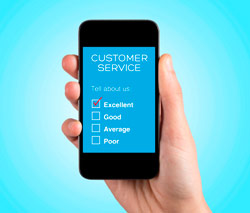By Mark Penson
 Retailers have relied on point-of-sale (POS) customer surveys since the days of pens and clipboards to get a better idea of what customers want from their shops. Today, however, there are much better ways to accomplish the same thing, at a fraction of the cost – through mobile technology. Here are just a few of the creative ways brands are leveraging consumers’ mobile devices.
Retailers have relied on point-of-sale (POS) customer surveys since the days of pens and clipboards to get a better idea of what customers want from their shops. Today, however, there are much better ways to accomplish the same thing, at a fraction of the cost – through mobile technology. Here are just a few of the creative ways brands are leveraging consumers’ mobile devices.
Mobile surveys improve POS data for a smaller investment.
Fully branded mobile surveys are simple to create and cost a fraction of human surveyors. The best mobile survey platforms don’t require consumers to install an app before they participate, but can be easily and quickly accessed from anywhere on most mobile devices.
Mobile surveys turn POS into a point of insight.
Mobile surveys provide unparalleled real-time feedback. You’ll have access to respondents’ information the instant someone completes your POS survey or quiz. These real-time insights can alert you to a messaging or perception problem, lead to new-product ideas, or illustrate how seemingly unrelated market factors impact consumer perceptions.
Seven best practices for using mobile surveys to collect POS insights:
1) Put the invitation to participate on the package or store signage. A simple URL or QR code with an incentive to participate is all you need.
2) Gamify your effort with a quiz. Encourage participants to challenge their friends. Offer an incentive for “winning” the quiz, especially if they get others to participate. Offering something your customers perceive as valuable is essential.
3) Design your mobile survey or quiz with your brand in mind. The interaction customers have with your brand during the survey should look and feel like the rest of your brand: logo, fonts, colors, messaging, and tone.
 4) Tell them it’ll take less than a minute. People will only give you so much time, even in the hopes of winning a prize. Tell them up front that they won’t be spending more than 60 seconds on your survey. Keep your word.
4) Tell them it’ll take less than a minute. People will only give you so much time, even in the hopes of winning a prize. Tell them up front that they won’t be spending more than 60 seconds on your survey. Keep your word.
5) Improve your survey or quiz as you go. Because you’re only printing your survey’s gateway (e.g., the link or QR code), you can revise or edit the questions participants see even after it’s live. If you solicit open-ended comments and notice a theme, you can add a new question addressing it.
6) Collect participants’ email addresses. You can make this a mandatory aspect of taking the survey (you can always change this on the fly if you’re not getting sufficient responses). One benefit of collecting emails is that you’ll be simultaneously building your database as you collect feedback. You’ll also have an immediate way to correct a problem a respondent identifies or reward participants with coupons or special offers.
7) Offer an installed solution for people who don’t have a mobile platform. Depending on how many locations from which you want to collect, you can install a secured tablet on a pedestal or somewhere in the store. Call it out with a sign or floor sticker. It doesn’t take much, as most people are attracted to interacting with a sleek and shiny tablet if they don’t have their one of their own.
Creating a mobile survey is easy, fast and requires no design or technical skill
Anyone can leverage the power of mobile surveys and quizzes because they are increasingly easy to build with simple point-and-click online tools. Branding your quiz is often as easy as uploading your logo. On many survey platforms, you can even add photos, video and audio files to enhance interactivity. When you’ve finished the short creation process, including writing your questions and answers, the online platform will generate a unique URL and QR code your audience will use to access the survey or quiz—without needing to download an app.
POS insights are priceless and easier to get than ever.
An estimated 70 to 80 percent of the world’s adult population owns a mobile device, and the number climbs daily. Harnessing the power of smart phones and tablets to engage consumers as they’re experiencing your brand is simple, affordable and fast. The real-time insights that await you can revolutionize what you know about your customers and how you market to them.

 Mark Penson is CMO of Survey Anyplace (
Mark Penson is CMO of Survey Anyplace (